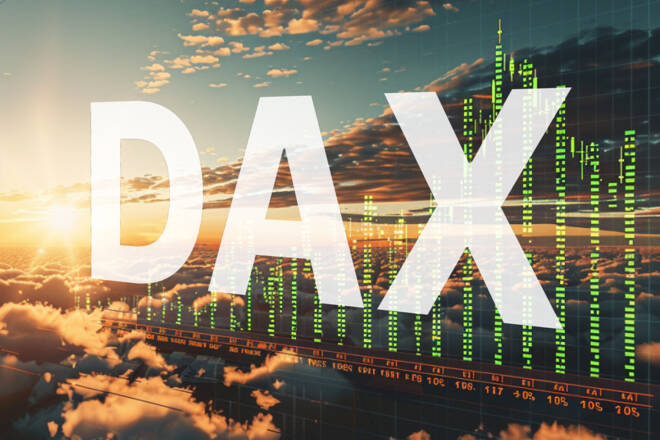Advertisement
Advertisement
Dax Index News: Outlook Mixed as Labor Data, Tariffs and ECB Path Jolt DAX Forecast
By:
Key Points:
- DAX surged 1.7% on April 1, ending a four-day slide, lifted by easing Eurozone inflation and risk-on sentiment.
- Tariff risks remain high; a 25% US auto import duty could reverse DAX gains and hit German exporters hard.
- Tariff announcements to steer DAX near-term moves.
DAX Rallies on the Eve of Tariff Announcements
Market volatility remained elevated at the start of Q2 2025 as investors awaited Trump’s Liberation Day (April 2) tariff announcements. However, weaker Eurozone inflation data and a pickup in risk sentiment triggered a broad-based rally across European equities. The DAX snapped a four-day losing streak, surging 1.70% on Tuesday, April 1, to close at 22,540.
DAX Leaders: Banks Drive Gains Despite Tariff Uncertainty
Despite increasing uncertainty over US tariff policy, only six of the 30 DAX constituents closed lower.
- Banking stocks soared, led by Commerzbank, up 7.39%, while Deutsche Bank advanced 1.97%.
- Airbus Group rallied 3.13% after reporting a sharp increase in March aircraft deliveries.
- Tech stocks Infineon Technologies and SAP rose 1.86% and 2.35%, respectively.
- However, the auto sector had a mixed session amid looming 25% tariffs. Volkswagen, BMW, and Mercedes-Benz Group closed higher, while Daimler Truck Holding and Porsche dipped 0.05% and 0.35%, respectively.
Eurozone Inflation Eases, Boosting ECB Rate Cut Bets
While tariffs dominated headlines, Eurozone inflation data bolstered expectations of further monetary policy easing. Core inflation slipped from 2.6% in February to 2.4% in March, edging closer to the ECB’s 2% target. Headline inflation eased to 2.2%, boosting bets on multiple ECB rate cuts.
Fred Ducrozet, Head of Macroeconomic Research at Pictet Wealth Management, commented:
“Euro area services inflation eased to 3.4% in March – great progress though not a surprise to anyone watching leading indicators. Expect some noise in the short-term, but confirmation that inflation dynamics are different from the US.“
However, Ducrozet highlighted tariff risks, stating:
“Euro area core HICP inflation eased to 2.41% in March. ECB staff projections have core at 2.5% in Q1, down to 2.2% in Q2. There’s a risk of a small rebound in April due to Easter, before core eases again. Not all clear for back-to-back ECB cuts, but ofc there’s the tariffs shock.”
US Data Supports a Dovish Fed Outlook
On April 1, US economic indicators supported the case for a more dovish Fed rate path.
- JOLTS Job Openings declined to 7.568 million in February, down from 7.762 million in January.
- ISM Manufacturing PMI dropped from 50.3 in February to 49.0 in March, with the Employment Index sliding from 47.6 to 44.7.
A contraction across the manufacturing sector and softer labor market conditions could affect wage growth, potentially dampening consumer spending and demand-driven inflation. However, higher tariffs may add to inflationary pressures, complicating the Fed’s outlook.
US Markets Mixed Ahead of Key Tariff News
US equity markets were steady on Tuesday, April 1. The Nasdaq Composite Index and the S&P 500 rose 0.87% and 0.38%, respectively, helping the Nasdaq snap a four-day losing streak. However, the Dow slipped by 0.03%, dragged down by a 7.59% plunge in Johnson & Johnson after a judge rejected a $10 billion talc settlement.
Market Outlook: Labor Market and Tariffs in Focus
Investor focus now turns to US labor market data and the upcoming tariff announcements.
Economists predict the ADP report will show a 105k job increase in March, up from 77k in February. Strong labor market data could dampen Fed rate cut expectations, weighing on risk assets. However, upbeat numbers could ease recession fears, potentially boosting demand for German-listed stocks.
Meanwhile, tariff developments will be crucial for the DAX’s near-term trajectory. A 25% tariff on all autos imported into the US and reciprocal levies would likely trigger a flight to safety, hitting German exporters. Conversely, signs that Trump may scale back tariff plans could fuel another DAX rally.
Near-Term Outlook: Key Drivers
The DAX’s direction hinges on three primary drivers: the US labor market, tariff headlines, and central bank signals.
Potential DAX Scenarios:
- Bullish Case: Easing trade tensions, upbeat US labor market data, or dovish central bank forward guidance may drive the DAX toward 23,000.
- Bearish Case: Higher tariffs, weak US data, or more hawkish central bank stances could drag the DAX toward 22,000.
As of Wednesday morning, the DAX futures were down 54 points, while the Nasdaq 100 mini dropped 34 points, signaling a volatile session ahead.
DAX Technical Indicators
Daily Chart:
After Tuesday’s rally, the DAX remains above the 50-day and 200-day Exponential Moving Averages (EMAs), maintaining a bullish technical bias. However, tariff-driven volatility poses short-term downside risks.
- Upside Target: A break above 22,750 would support a climb toward 23,000. A sustained move through 23,000 could enable the bulls to target the record high of 23,476.
- Downside risk: A drop below 22,500 could expose the 50-day EMA. A decisive break below the 50-day EMA could bring 22,000 into play.
With the RSI at 48.48, the DAX remains above oversold territory (below 30), leaving room for a drop to 22,000.
Conclusion: Monitor Key Macro Catalysts
Investors should closely monitor US labor market data, tariff announcements, and central bank commentary. These factors will affect DAX price action in the coming sessions.
Explore our latest research here for deeper insights into the DAX, global macro trends, and emerging market opportunities.
About the Author
Bob Masonauthor
With over 28 years of experience in the financial industry, Bob has worked with various global rating agencies and multinational banks. Currently he is covering currencies, commodities, alternative asset classes and global equities, focusing mostly on European and Asian markets.
Did you find this article useful?
Latest news and analysis
Advertisement
